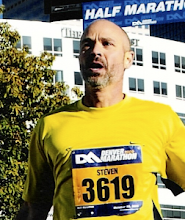Part of the FIRST Run Less Run Faster program is that you must cross train at least 2 days during the week, with an optional third day. As you might guess, they recommend cycling or swimming for cross training. In both cases you get a good aerobic workout and, importantly, don't use the weight bearing muscles in your legs. There is also some other complimentary goodness that comes along with either of these activities. With two great choices, this ought to be an easy one.
I have only two problems with this:
- I hate cycling.
- I hate swimming.
I'm sure you've run into at least one person who goes on about how much they hate running, but they force themselves to do it anyway because they know that it is good for them. Then they start detailing how brutal it is for them to run and how all the time they are thinking "when can I stop". To which I usually say, "um, stop now". Life is too short to waste time on optional activities that you dislike. Find something you enjoy doing (swimming, cycling, badminton, tennis, soccer, team handball, whatever) and do that instead.
Not one to eschew my own advice, I had decided (before adopting the
FIRST program) that I wasn't going to cycle and I wasn't going to swim. Fortunately, I have a most excellent wife, who knows me quite well and in anticipation of this issue, she gave me a
heavy bag for my birthday at the end of October. Besides being a lot of fun, you get a pretty good work out punching the bag. At this point, I'm doing 8 rounds of 3 minutes each, with a 30 second rest. I'm keeping the punches and combinations relatively simple at this point, as I'm working on proper form, so as not to get injured. If you have some interest in doing this, you would be best off to get some coaching.
Even with the hand wraps and bag gloves, I managed to take a chunk of skin out of the knuckle on one finger. And of course, every time I work out now, the scab on that knuckle splits open again. I'm really curious how long it will take to heal...
But other than that, I feel like I'm getting a very good work out. I combine heavy bag training with
Turbulence Training from
Craig Ballantyne. I've been doing the program since February of this year, and have nothing but good things to say about it. As a runner, I've always felt that my lower body didn't really need any strength training (which shows my ignorance more than any thing else). While Turbulence Training (TT) is a total body workout, it really focusses on building core strength. Turns out developing core strength involves a lot of lower body exercises. And turns out, I didn't have much core strength.
The program also has an 'interval' training component that is the fat loss part of the program. I have this bizarre metabolism that seems to make it mostly impossible to gain weight (I'm not claiming this comes from running because I've had long periods in my life when I haven't run with no affect on my metabolism). In any case, I 'm not interested in the fat loss part of the program. You will find that Craig spends a lot of time bashing 'long slow cardio' as excruciatingly boring. Only thing is, I happen to love it. As long as it doesn't involve a bike or a pool.
But that aside, you can't go wrong with the program. One of the key concepts of TT is continual variety that challenges the body in new ways, forcing it do adapt and increase strength. To that end, the program comes with a number of workouts. Each workout has an A day and a B day and is done for 12 weeks. Then on to the next workout. Just 3 days a week, and if you do the exercises as instructed, you will get an incredible workout and experience a very noticeable improvement in strength within a few weeks. It's the best bang for time spent on strength training I've ever found. Oh, the program does cost $40, but I wouldn't hesitate, it is $40 well spent.
So a cross training day for me starts with a Turbulence Training session, then wrap the hands, slip on the bag gloves, and go 8 rounds with the heavy bag. Not only is it a good workout, but you know, sometimes it just feels good to hit something.
